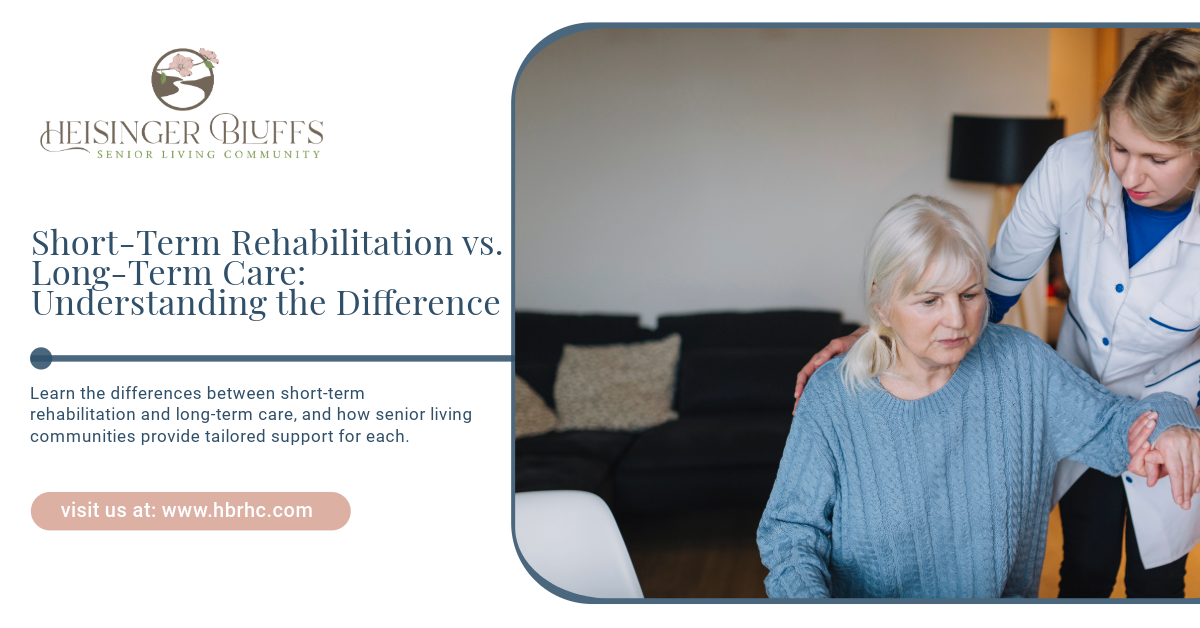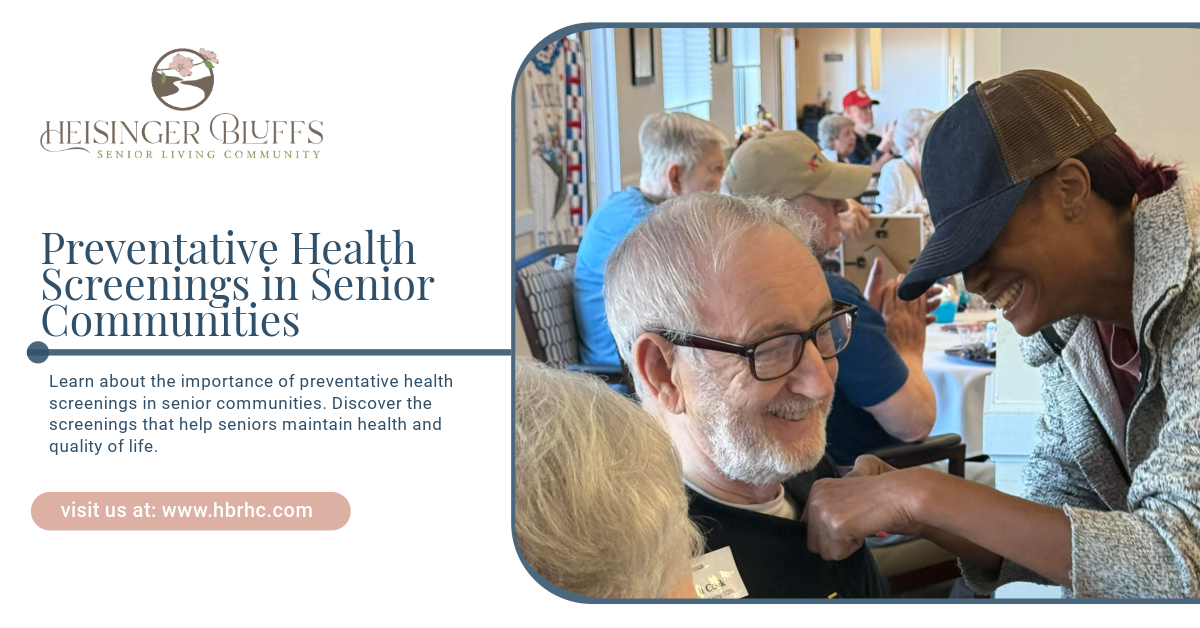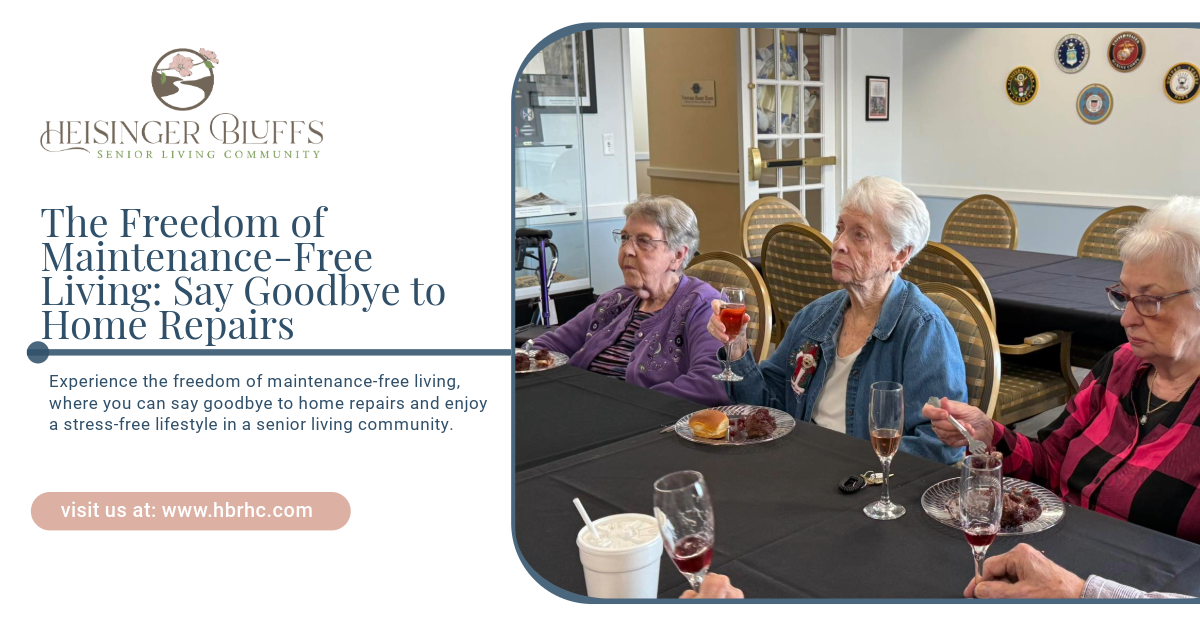Short-Term Rehabilitation vs. Long-Term Care: Understanding the Difference

As seniors age, their health needs can change, requiring different levels of care. Whether recovering from surgery, illness, or managing chronic conditions, understanding the difference between short-term rehabilitation and long-term care is crucial when deciding the best care plan for your loved one. Senior living communities cater to both short-term recovery needs and long-term care, offering comprehensive support based on individual circumstances.
In this blog, we’ll explain the key differences between short-term rehabilitation and long-term care, their purposes, and what to expect from each. We’ll also highlight how senior living communities are uniquely equipped to handle these care needs, ensuring the best possible outcomes for seniors.
What is Short-Term Rehabilitation?
Short-term rehabilitation, also known as post-acute care or transitional care, is designed to help seniors recover from illness, injury, or surgery. The goal of short-term rehabilitation is to restore independence and functionality so that individuals can return to their normal daily activities as quickly as possible.
Common Reasons for Short-Term Rehabilitation
Short-term rehabilitation is often necessary after:
- Surgery: Seniors who undergo joint replacements, heart surgery, or other major procedures typically require physical and occupational therapy to regain strength and mobility.
- Stroke: Recovering from a stroke often involves a combination of physical, speech, and occupational therapy to improve motor skills and communication.
- Injury: A fall or fracture can limit mobility and daily function. Rehabilitation helps seniors regain their balance and confidence in movement.
- Hospitalization: After an extended hospital stay due to illness or injury, seniors may need time to rebuild their strength before they can safely return home.
The duration of short-term rehabilitation varies, depending on the individual's health status and progress. Generally, these programs last from a few weeks to a few months. The aim is to improve physical function, manage pain, and prevent further complications, allowing seniors to return home with the skills and confidence needed to live independently.
Key Services Offered in Short-Term Rehabilitation
Short-term rehabilitation programs offer a range of services, including:
- Physical therapy: Physical therapists work with seniors to regain strength, improve balance, and restore mobility. This often includes exercises, stretches, and activities that focus on recovering from surgery or injury.
- Occupational therapy: Occupational therapy focuses on helping seniors regain the ability to perform everyday tasks such as dressing, bathing, and cooking. This type of therapy helps individuals rebuild their fine motor skills and adapt to any physical limitations.
- Speech therapy: Seniors recovering from stroke or other neurological conditions may require speech therapy to improve communication skills or address swallowing difficulties.
- Pain management: Short-term rehabilitation programs also focus on managing pain through medication, physical therapy, or other treatments to ensure seniors are as comfortable as possible during recovery.
- Nutritional support: Proper nutrition is crucial for healing, and dietitians create meal plans that support recovery and meet any special dietary needs.
The goal of short-term rehabilitation is to help seniors regain independence and functionality, so they can return to their normal lives. This type of care typically takes place in a senior living community or rehabilitation center, where trained professionals provide comprehensive support tailored to each individual’s needs.
What is Long-Term Care?
Long-term care is designed for individuals who have ongoing, chronic health conditions that require continuous medical supervision and support. Unlike short-term rehabilitation, which focuses on recovery and regaining independence, long-term care is about maintaining quality of life and providing consistent, around-the-clock care.
Common Reasons for Long-Term Care
Seniors typically require long-term care when they:
- Have chronic illnesses: Conditions like Alzheimer's disease, Parkinson's, or diabetes may require long-term medical management and personal care assistance.
- Have mobility issues: Seniors with mobility limitations or those who are bedridden may need long-term care to ensure their safety and comfort.
- Require assistance with activities of daily living (ADLs): Seniors who need help with tasks such as dressing, bathing, eating, or toileting may benefit from long-term care.
- Experience cognitive decline: Dementia and other cognitive impairments often require specialized care and supervision to ensure the individual's safety and well-being.
Long-term care is typically provided in a nursing home or skilled nursing facility, where seniors receive 24/7 supervision and medical care. This type of care is focused on managing chronic conditions, preventing complications, and improving the individual's overall quality of life.
Key Services Offered in Long-Term Care
Long-term care services include:
- Skilled nursing care: Trained nurses provide continuous medical supervision, administer medications, and monitor the individual’s health status.
- Personal care assistance: Long-term care facilities offer assistance with activities of daily living, including bathing, dressing, and eating. Staff members ensure that seniors are comfortable and maintain their dignity while receiving help with these tasks.
- Chronic condition management: Long-term care facilities are equipped to manage chronic conditions such as diabetes, heart disease, and dementia. This includes medication management, wound care, and monitoring vital signs.
- Recreational activities: To promote mental and emotional well-being, long-term care facilities often offer social and recreational activities. These activities can include art therapy, music therapy, group exercise classes, and social events.
- Nutritional support: Seniors in long-term care receive personalized meal plans that meet their dietary needs and promote overall health. Nutritional support is especially important for individuals with conditions that affect appetite or require special diets.
- Palliative care: For seniors with terminal illnesses, long-term care facilities may provide palliative care to manage pain and symptoms, ensuring that the individual is as comfortable as possible.
The focus of long-term care is on providing a safe and supportive environment where seniors can receive continuous care that enhances their overall quality of life.
Differences Between Short-Term Rehabilitation and Long-Term Care
While both short-term rehabilitation and long-term care provide essential services for seniors, they differ in several key areas:
| Aspect | Short-Term Rehabilitation | Long-Term Care |
|---|---|---|
| Duration | Temporary (a few weeks to a few months) | Ongoing (months to years) |
| Goal | To restore independence and functionality | To provide continuous care and maintain quality of life |
| Type of Care | Focused on recovery and rehabilitation | Focused on managing chronic conditions and daily care |
| Therapies Offered | Physical, occupational, and speech therapy | Chronic condition management, personal care assistance |
| Living Arrangement | Typically in a rehabilitation center or senior community | Typically in a skilled nursing facility |
| Level of Independence | Encourages independence as much as possible | Assistance with most or all activities of daily living |
| Care Provided | Medical care for recovery | 24/7 medical care and supervision |
How Senior Living Communities Cater to Both Needs
Senior living communities that offer both short-term rehabilitation and long-term care are uniquely equipped to cater to a wide range of needs. These communities provide a continuum of care, allowing seniors to transition between different levels of support as their needs change over time.
1. Short-Term Rehabilitation in Senior Communities
Senior communities offering short-term rehabilitation services typically have dedicated rehabilitation centers on-site. These centers provide comprehensive therapy programs, allowing residents to recover in a comfortable, supportive environment. After completing rehabilitation, seniors can either return home or, if needed, transition to long-term care within the same community.
Key benefits of short-term rehabilitation in a senior community include:
- Continuity of care: Seniors receive seamless care from the same healthcare team, whether they are in short-term rehabilitation or long-term care.
- Familiar environment: If a resident transitions from independent living or assisted living to short-term rehabilitation, they can recover in a familiar setting.
- Access to amenities: Senior communities often provide amenities such as dining services, recreational activities, and social events, even for those in rehabilitation.
2. Long-Term Care in Senior Communities
Senior communities that offer long-term care provide a higher level of medical supervision and personal care. These communities often have skilled nursing facilities where residents receive 24/7 care and support. Long-term care residents benefit from:
- Personalized care plans: Each resident’s care plan is tailored to their specific health needs, ensuring they receive the appropriate level of care.
- Access to skilled nursing staff: Skilled nurses and certified nursing assistants are available around the clock to provide medical care, medication management, and personal assistance.
- Opportunities for social engagement: Despite requiring long-term care, residents still have access to social and recreational activities, which contribute to their emotional well-being.
- Family involvement: Many senior communities encourage family members to stay involved in their loved one’s care, providing a sense of connection and comfort.
By offering both short-term rehabilitation and long-term care, senior communities ensure that residents have access to the care they need, no matter how their health needs evolve.
Choosing the Right Care Option for Your Loved One
Deciding between short-term rehabilitation and long-term care for a loved one can be challenging. It’s important to consider factors such as their current health status, their recovery goals, and their ability to perform daily tasks independently.
If your loved one is recovering from surgery, illness, or injury and is expected to regain their independence, short-term rehabilitation is likely the best option. On the other hand, if they have a chronic health condition or require ongoing medical supervision and assistance with daily activities, long-term care may be more appropriate.
Working closely with healthcare professionals can help you determine the best care plan for your loved one, ensuring they receive the support and services they need to live comfortably and safely.
Conclusion
Understanding the difference between short-term rehabilitation and long-term care is key to making informed decisions about your loved one’s health and well-being. Senior living communities like Heisinger Bluffs offer both options, ensuring that residents receive the appropriate care at every stage of their journey. Whether your loved one is recovering from surgery or requires ongoing support for a chronic condition, these communities provide comprehensive, compassionate care that enhances their quality of life.











